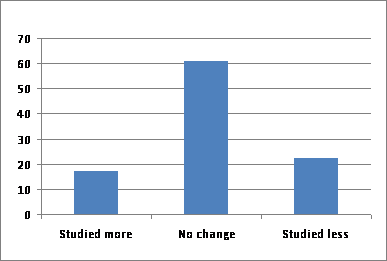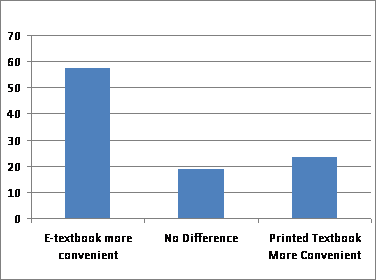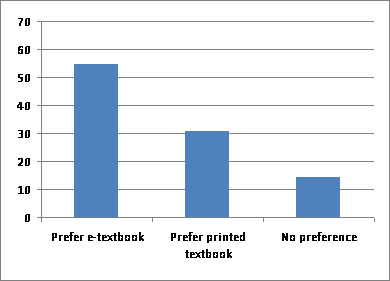- A typical college student spends up to $1,000 per year on textbooks, and many students don’t buy textbooks at all because they’re too expensive.
- E-textbooks can cost up to 50 percent less than standard textbooks while providing the foundation for integration of multiple learning resources into a single delivery system.
- E-textbooks and their enhanced interactive learning resources also have the potential to accelerate student learning.
The cost of student textbooks is a growing concern among higher education’s constituency of students, parents, and state legislatures. This concern also appeared as part of the cost-containment goals for higher education as framed by the Higher Education Reauthorization Act passed by Congress in late 2008.
At most universities a student typically goes to a bookstore to purchase the textbook recommended by the professor for a course. The student may choose to purchase a new or used textbook, or, as occurs more frequently now, an e-textbook (see "Electronic Books"). Nearly 40 percent of college students choose not to purchase textbooks at all, however, due to the costs.1
Generally, e-textbooks are the digital media equivalent of printed textbooks, read on personal computers, e-readers, or smart phones. Any textbook can be a more powerful learning resource if augmented with review quizzes, recommended and targeted review readings, interactive learning activities, or video segments to reinforce important instructional concepts. These enhanced learning resources, which are much easier to integrate and deliver in the e-textbook format, have the potential to accelerate student learning.2 In the long haul, the success of e-textbooks will probably depend on their contributions to interactive learning and the convenience of integrating multiple learning resources into a single delivery system.
This article focuses on the process that Northwest Missouri State University followed in studying the feasibility of transitioning from the rental of traditional textbooks to the rental of e-textbooks, along with the extensive integration of e-textbooks across the university’s academic environment. (See "Northwest Textbook Rental Program and Electronic Campus" for further details.) The process consisted of three phases, with changes made along the way to reflect feedback and insights gained from students, faculty, and administrators involved in the program.
Phase I: E-Book Readers
In the summer of 2008 the president’s cabinet at Northwest Missouri State University was given a demonstration by President Dean Hubbard of Amazon’s Kindle wireless reading device and quickly agreed that Northwest’s textbook rental program for students needed review. The university thus undertook a pilot study to determine the feasibility of using e-textbooks.
Preliminary to the study, a functional analysis was conducted in which the Kindle was compared to Sony’s Reader Digital Book by President Hubbard; Paul Klute, assistant to the president; and Jon Rickman, vice president for information systems. Although both devices are similar in size and screen design,
- The Kindle features broadband communications and permits wireless purchasing and downloading of e-books.
- The Sony reader requires downloading a purchased e-book from the Internet to a PC before it can be downloaded to the e-reader via a USB cable.
Northwest already provided laptop computers to all of its full-time students and preferred to avoid the proprietary Kindle platform (as well, Amazon lacked interest in participating in such a study). The open-source PC-based e-book environment of the Sony Reader appeared to be a better fit, and pricing and e-textbook availability helped solidify its selection for deployment during Phase I of the pilot study of the e-textbook initiative. (See "E-Readers" for more information.)
Roger Von Holzen, director of Northwest’s center for online curriculum development and support (Center for Information Technology in Education — CITE), confirmed that several online classes already used e-textbooks. These e-textbooks and other electronic materials were integrated into and delivered efficiently to students through Northwest’s eCollege course management system.
At the fall 2008 campus-wide faculty meeting, the features of the newest e-readers were presented by President Hubbard, as were the potential cost savings for the student textbook rental program and associated student fees. At the end of the meeting, Northwest’s president asked for faculty volunteers to participate in having their classes try an e-reader and e-textbook for at least part of the fall semester. Over 50 faculty members volunteered, with four selected based mostly on the availability of appropriate e-textbooks for their courses. About 200 e-readers were purchased for Phase I of the pilot study, which investigated whether e-readers were the optimal means for distributing e-textbooks. The e-textbooks were loaded and the e-readers distributed to students by early October.
We learned much in the two months of Phase I:
- A textbook includes multiple components, such as graphs and images, all with separate copyrights.
- The formatting for e-readers can require weeks to complete.
- There are currently not enough e-reader–compatible e-textbooks for campus-wide deployment.
- Most e-textbooks are available only through laptop computers and/or web access.
- PDF-formatted textbooks have restrictive and slow navigation options.
- Students have a high affinity for handheld electronic devices.
- Students like the idea of not having to carry 20 or 30 pounds of textbooks in their backpacks.
- Keyword searching and annotating are very important features for students and faculty.
- The enthusiasm for e-readers quickly waned without the desired search and annotation features.
- Students found the e-readers were attention getters but not attention keepers.
- No accessibility issues or challenges were encountered with the e-readers and e-textbooks.
Focus group sessions held near the end of the fall semester with the students and faculty involved in Phase I of the e-textbook pilot helped determine that the Sony Readers were not ready for full deployment. The Sony model tested lacked search and annotation features (see Table 1) and could not display color images or multimedia programs. Finally, the Sony Reader could not provide active web links within the e-textbooks. On the other hand, student laptop computers did provide these capabilities. We therefore decided to evaluate e-textbooks compatible with student laptops during Phase II of the initiative, during the spring 2009 semester. (See "Laptops as E-Readers.")
Table 1. Sony Reader Versus Laptop Computer as E-Book Reader
| Features | Sony Reader PRS-505 | Laptop Computer |
| Color capable | NA | Yes |
| Animations | NA | Yes |
| Interactive functions (quizzes, video, etc.) | NA | Yes |
| Search function* | NA | Yes |
| Annotation/highlighting capability | NA | Yes |
| Wireless Internet capability | NA | Yes |
| Links to external resources | NA | Yes |
| Integrates academic learning tools and resources | NA | Yes |
* Search available with Sony Reader PRS-700
In terms of cost, Northwest considers the laptop computer a basic service that cannot be replaced by current e-reader technology. Therefore, the study had to consider the additional cost of the e-readers.
Phase II: Laptop Computers
Phase II of the e-textbook initiative aimed to evaluate e-textbooks designed for use on student laptops. This phase, completed during the spring semester of 2009, concentrated on the deployment of e-textbooks provided by five publishers. Of a possible 19 academic departments, 11 volunteered to participate in this phase. Across the 11 departments, 20 classes were selected to use e-textbooks. Approximately 500 students were involved in the study.
Table 2 shows some of the courses involved in Phase II and the accompanying e-textbook titles, with publishers, used for the semester. In both Phase I and Phase II, the availability of the e-textbook version of a textbook was determined only after the standard printed textbook had been selected by faculty. Six courses that had sections using e-textbooks also had sections using traditional textbooks.
Table 2. Northwest Courses in Spring 2009 Pilot
| Pilot Course Title | Cost of Traditional Textbook | Approximate Cost of E-Textbook (Publisher Platform) |
| Fundamentals of Business Finance* | $168.00 | $72.25 (VitalSource) |
| Human Resources Management* | $130.00 | $68.75 (VitalSource) |
| Intercultural Communication* | $95.00 | $51.48 (Coursemart — 180-day subscription) |
| Management Information Systems* | $140.00 | $71.49 (Coursemart — 180-day subscription) |
| Introduction to Psychology | $121.00 | $62.95 (Coursemart —180-day subscription) |
| The Enjoyment of Music* | $130.00 | Not available |
| Reporting Pupil Progress | $69.00 | Not available |
| Pluralism and Multiculturalism* | $81.00 | Not available |
| College Algebra (MyMathLab) | $130.00 | Not available |
* Courses with some sections using e-textbooks and others using traditional textbooks.
Phase II e-textbook delivery was provided through several different publisher platforms (shown in Table 2). McGraw-Hill content (Fundamentals of Business Finance, Human Resources Management) was delivered to students through the VitalSource platform. Unique access codes, e-mailed to students in these classes, allowed students to download the e-textbooks to the VitalSource platform. Students gaining access to Cengage Learning content (Intercultural Communication, Management Information Systems) were assisted by Cengage publishing representatives during in-class training sessions. Content from Pearson (Pluralism and Multiculturalism, College Algebra) was integrated into eCollege course sites, Northwest’s course management system. Norton content (Enjoyment of Music) and BFW (Bedford, Freeman, and Worth) content (Introduction to Psychology) were delivered via e-mailed access codes.
As with Phase I, Phase II provided interesting findings:
- Delivery of e-textbooks to student laptops was simple and efficient.
- Students could download e-textbooks with little assistance from university support staff.
- Several publishers provided enhanced e-textbooks with quizzes and shared notes.
- Standardized reading features looked useful, as some students used multiple e-textbooks.
- Students liked the idea of carrying lighter backpacks.
- The VitalSource platform allowed students to share notes and highlights.
- Some e-textbook features, if used in the classroom, needed additional Wi-Fi connectivity.
- Student and faculty reactions to Phase II of the e-textbook project were generally positive. (See a video from KQ2 News with commentary from students and staff.)
A survey of students actively involved in Phase II of the project gathered data on how the use of e-textbooks affected their reading and study habits. Students were also asked general questions about the e-textbooks themselves. Survey results shown in Figure 1 indicate that 60 percent of the students felt they read more when using physical textbooks than they did using e-textbooks.

Figure 1. Amount of Student Reading
The impact of e-textbooks with respect to students’ overall study habits looked neutral, as indicated by the survey results shown in Figure 2. Overall, most students did not see any change in their study habits when using an e-textbook versus a traditional textbook.

Figure 2. Student Study Habits with E-Textbooks
When asked if the e-textbooks were more convenient for accessing and retrieving information, the majority of students (56.25 percent) indicated that e-textbooks significantly outperformed regular physical textbooks (see Figure 3). When asked their preference for e-textbooks over physical books if the use of e-textbooks would result in maintaining the current textbook rental fee (versus a possible increase in the fee due to rising costs of printed textbooks), the majority of students indicated they would opt for the use of e-textbooks (see Figure 4). But a surprising 31 percent would still prefer a physical textbook.

Figure 3. E-Textbook Convenience

Figure 4. Preference if Use of E-Textbooks Keeps Rental Fee from Increasing
Overall survey results show that 47 percent of the students still prefer physical textbooks but also reveal a significant set of early adopters willing to explore the realm of e-textbook technology. The survey clearly shows that cost considerations play a major role in student decision making with respect to e-textbooks versus physical textbooks. When asked if they would prefer e-textbooks over printed textbooks if by using e-textbooks the textbook rental feel would not increase, 55 percent of the students replied that they would prefer the e-textbooks.
The outcome of these time-on-task comparisons, along with cost comparisons, was very important in determining the scope of Phase III of the initiative.
Phase III: Implementation
The implementation phase aims primarily to manage the transition to e-textbooks in a way that contains costs and obtains the support of students, faculty, and the administration. Early on in the e-textbook initiative, we thought e-textbooks could replace traditional textbooks over a three- or four-year period. It quickly became evident that the process was too complex for that schedule and that many factors would drive the timing, a major one being the availability of e-textbooks for certain disciplines and content areas.
In addition, Northwest Missouri State University has a major investment in its current inventory of traditional textbooks. The university cannot afford to abandon this inventory or to immediately duplicate it with electronic editions. Because traditional textbooks are replaced on a planned cycle, consideration can be given to an electronic replacement as each textbook reaches the end of its use in the rental program. Adjusting the replacement process in this way is imperative to achieve cost savings that would otherwise be lost.
The quality of e-textbooks appears to be improving at a steady pace. In discussions with the publishers, they have indicated their commitment to the new technology through research into a new vision for e-textbooks. They also have indicated that they plan to continue to invest in enhancement of their current electronic offerings.
Faculty members are key decision makers in selecting course content and adopting new learning resources. With textbook options of equal quality and equivalent content, however, students need cost information to help them decide between printed and electronic texts. In the textbook rental environment, all the facts must be made public so that suitable decisions can be made at appropriate times, for the good of all.
An extensive survey conducted by a national marketing firm revealed that Northwest students and graduates value the textbook rental and laptop programs. We thus consider it imperative that these programs continue to improve as technologies change.
Northwest is committed to providing lower cost e-textbooks as rapidly as feasible, tempered by the quality and ease of use for faculty and students. As before, students will have the final word on the e-textbooks available through the textbook rental program. In the end, though, it will be the integration of e-textbooks with supporting multimedia and other learning resources that will ensure that e-textbook technology becomes the core of students’ educational experiences.
- Susan Kinzie, "Swelling Textbook Costs Have College Students Saying ‘Pass’," Washington Post, January 23, 2006, p. A01.
- Joseph D. Novak, "The Promise of New Ideas and New Technology for Improving Teaching and Learning," Cell Biology Education, vol. 2, no. 2 (2003), pp. 122–132.
- California Public Interest Research Group (CALPIRG) Education Fund, "Affordable Textbooks for the 21st Century," July 14, 2005.
- Michael Singer, "PC Milestone — Notebooks Outsell Desktops," CNET News, June 3, 2005.
© 2009 Jon T. Rickman, Roger Von Holzen, Paul G. Klute, and Teri Tobin. The text of this article is licensed under the Creative Commons Attribution-Noncommercial-No Derivative Works 3.0 license.

